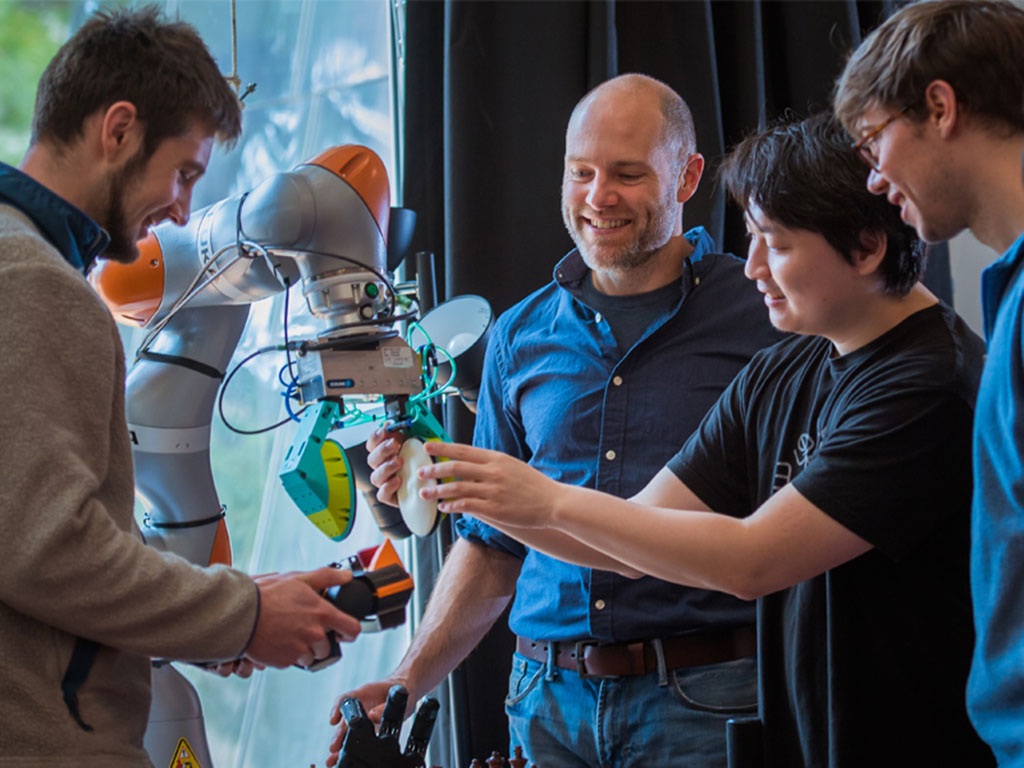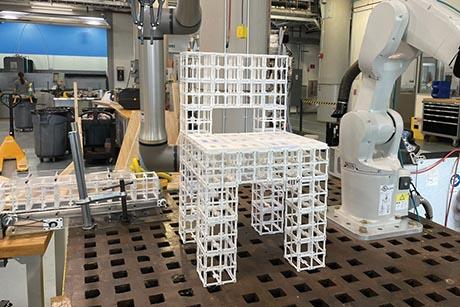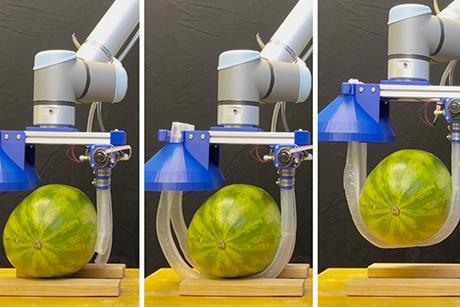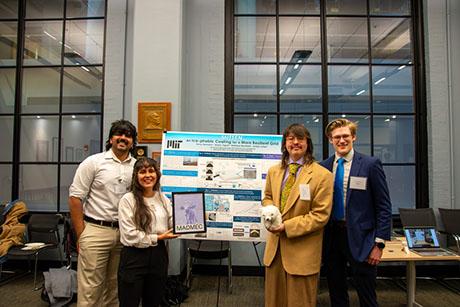Manipulating the future
As robots evolve, society’s collective imagination forever ponders what else robots can do, with recent fascinations coming to life as self-driving cars or robots that can walk and interact with objects as humans do.
These sophisticated systems are powered by advances in deep learning that triggered breakthroughs in robotic perception, so that robots today have greater potential for better decision-making and improved functioning in real-world environments. But tomorrow’s roboticists need to understand how to combine deep learning with dynamics, controls, and long-term planning. To keep this momentum in robotic manipulation going forward, engineers today must learn to hover above the whole field, connecting an increasingly diverse set of ideas with an interdisciplinary focus needed to design increasingly complex robotic systems.
Last fall, MIT's Department of Electrical Engineering and Computer Science launched a new course, 6.800 (Robotic Manipulation) to help engineering students broadly survey the latest advancements in robotics while troubleshooting real industry problems. It’s a unique course that can provide an inroad into robotics for students with no robotics experience at all, designed by Russ Tedrake, the Toyota Professor of Electrical Engineering and Computer Science, Aeronautics and Astronautics, and Mechanical Engineering at MIT. Tedrake developed the course after robotic manipulation became the new focus of his own research at the Toyota Research Institute and MIT’s Robot Locomotion Group, and it became apparent to him that developing a pedagogical framework would be important because the field is so diverse and changing so rapidly.
 Professor Russ Tedrake (second from left) examines a robotic arm with students from 6.800 (Robotic Manipulation). Tedrake designed the course in response to the growing need for engineers to survey the latest advancements in robotics while gaining experience in troubleshooting real industry problems. Photo Credit: Gretchen Ertl
Professor Russ Tedrake (second from left) examines a robotic arm with students from 6.800 (Robotic Manipulation). Tedrake designed the course in response to the growing need for engineers to survey the latest advancements in robotics while gaining experience in troubleshooting real industry problems. Photo Credit: Gretchen Ertl“It was time for there to be a single place where you could really get a view of all the pieces,” Tedrake says.
His students learn fundamental algorithmic approaches to build robot systems capable of autonomously manipulating objects in unstructured environments. Exploring topics like perception, planning, dynamics, and control, students solve problem sets to guide themselves through developing a software stack, typically using the permissively licensed open-source software Drake — which is why industry leaders watch Tedrake’s lectures, too. Not focused on quizzes and final exams, the course culminates instead with a final project where students can explore any problem in robotic manipulation that fascinates them.
Undergraduate engineering student David von Wrangel is currently in the course. His background is in rocketry and propulsion, and he only just became interested in robotics through a recent mobile robotics internship at Tesla. Learning what it took to make a robot move around, soon his next question became: how can a robot be made to pick something up? That’s when a colleague at his internship told him about MIT’s Robotic Manipulation course.
“I was super excited, because that was exactly what I was missing: now that you can manipulate your robot, you just need to figure out how to use manipulation to move other things,” von Wrangel says.
Tedrake’s course notes provide students like von Wrangel with a window to peer across the professor’s own mental landscape of the field. Students say they are unlike any course notes they’ve ever seen — providing a constantly updated roadmap of what it would take to advance robotics as a field.
Teaching assistants (TAs), like PhD student H.J. Terry Suh last fall, develop problem sets that offer students opportunities to apply less familiar concepts and see for themselves how various disciplines connect.
That potential to gain a new point of view in robotics is precisely what drew graduate student Anubhav Guha to the course. His research focuses on applications of controls, and he took the course to examine open-ended problems in robotics that directly related to his research. “I kind of wanted to explore the field a bit and get a feel for the technical problems,” Guha says.
Tedrake says there’s rampant industry interest in engineers skilled in manipulation, and that demand helped motivate him to launch the course. “Manipulation is just kind of exploding in the field,” Tedrake says, adding that recently, “it's less of a niche area, everybody's got an eye on making robots do things with their hands.” Right now, the big companies are investing.
They aren’t the only ones invested in the future for robots. Because there was so much student interest in the course, Tedrake decided to open Robotic Manipulation enrollment up to both undergraduate and graduate students.
For PhD student Daniel Yang, who took the course when it was first offered last fall, his interest in robotic manipulation increased while working in industry and seeing the limited environments in which robots currently operate. As part of the MIT/Woods Hole Oceanographic Institution (WHOI) Joint Program, Yang collaborates with oceanographers, helping to build autonomous robotic systems capable of diving into the water to collect scientific data.
“Broadly, I'm interested in getting robots out in the real world,” Yang says.
For Yang’s course final project, he was inspired to explore the inner workings of a throwing robot like Google’s TossingBot. Collaborating with a partner to build their own ball-throwing robot in a simulator, they were able to clearly document effects that threw the robot off its tossing game, because the course simulator allowed them to freeze and reexamine every interaction while troubleshooting. For one example, they realized that the accuracy of their robot’s throwing arm was limited because the exact physics of how the ball interacted with the robot’s gripper were still unknown.
“You may think picking something up with your fingers is quite simple,” Yang says. “But when you try to translate that into simulation, there’s just so much added complexity.”
Suh says that Guha’s final project was among the most ambitious. Guha created an entire simulated manipulator system that pieces together a puzzle using a camera system that detects the correct image placement and orientation for each puzzle piece.
“Some other projects kind of focused on one aspect of the manipulation pipeline, like grasping or perception,” Guha says. “And they really went in deep into that. And I wanted to explore all of the different components that are required to make a fully functioning system.”
Tedrake says that whether students decide to focus on one aspect of the manipulation pipeline or tackle an entire system, solving problems at any level equates to a great success in this fast-growing field that’s hungry for solutions.
“Even if it's an algorithm that I know well, but I see what they struggled with, or how they made work, it sharpens my understanding of the algorithm,” Tedrake says.
Tedrake takes many of the solutions found in his class directly into the lab, pushing forward his own research and gaining new research ideas each week. And sometimes he brings the students with him. That’s what happened with von Wrangel, whose enthusiasm for the course led Tedrake to recruit him to help refine algorithms for Tedrake’s Robot Locomotion Group.
Yang and Suh agree with Tedrake that the future of robotic manipulation is coming fast and the Robotic Manipulation course will help train engineers to steady the field as it advances.
“I think the last few years, there's been so many advances in all these different fields, but there hasn't been anything that ties them together into one specific problem space,” Yang says.
Suh thinks people will start seeing more advancements in everyday life, and as that happens the Robotic Manipulation course will be there as a resource. His vision of the future sees robots everywhere.
“It's going to be sort of manipulation in the wild, where we'll have robots go inside arbitrary places, like people's homes or kitchens, and carry out very delicate manipulation tasks that we would usually expect humans to do,” Suh says.
For von Wrangel, the future of robotic manipulation will help us go well beyond the seeming luxury of self-driving cars and robot task-rabbits. “I'm very much into space exploration and humans becoming multi-climate and multiplanetary species,” von Wrangel says. “And I believe that robots could help us build our future on Mars.”
In its second year, Robotic Manipulation keeps inspiring bigger and bolder ideas from students, who ply TAs like Suh with sometimes esoteric questions in the middle of the night, always seeking guidance to better simulate systems. Tedrake says the ideas for final projects this year have already been more ambitious than last year. Each project, tweaking each algorithm little by little or imagining entire systems from a unique point of view, will serve a role in driving innovation in the field.
“Some years, with student projects, it's more like, I want to try this paper and just make it a little bit better,” Tedrake says. “And this year, it's like, I want a robot that’s going to tie my shoes.”


